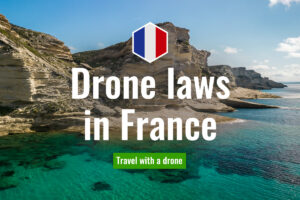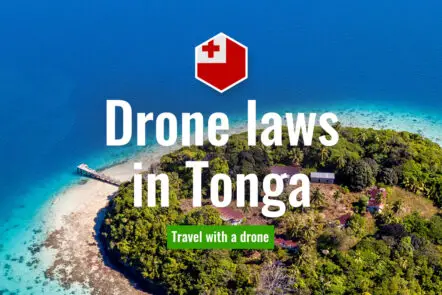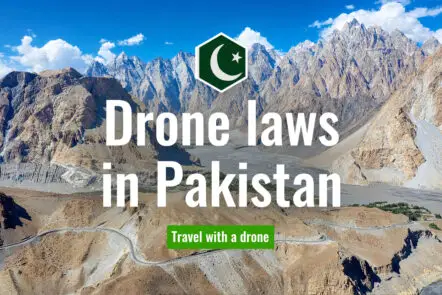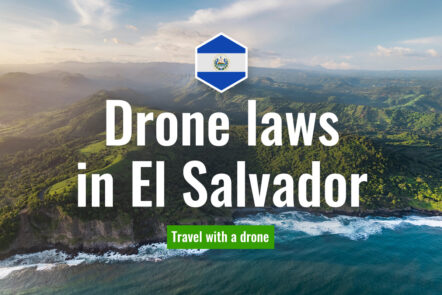Drone regulations in France
Verfasst von Francis Markert | Last update on 09.07.2025 | 40 Kommentare
France is easy to reach and therefore makes an interesting travel destination. In this article, you’ll learn which laws you need to follow as a drone pilot in our neighboring country.

Since the end of 2020, the EU Drone Regulation has been in effect in France. This means that the rules for remote pilots have been largely standardized. You only need to register as an operator in one European country (in most cases, the country where you live), and your EU drone license is recognized across countries. However, there is one additional bureaucratic hurdle that some drone pilots should keep in mind before traveling to France. All the details can be found below.
Overview of the European rules with effectiveness in France
In France, the regulations of the European Aviation Safety Agency (EASA) apply. The following is a summary of the key facts. For a complete overview, read our article on the new EU drone regulation.
National specificities in France
Each country can define certain aspects of its drone regulations. For France, the following requirements apply in addition to the European regulations.
Remote Identification
In addition to the European requirement for operator registration, which applies to the operation of all camera drones, France has its own parallel system. In France, not only must the operators be registered, but the drones themselves must also be registered. This registration becomes relevant for you if the following two conditions apply:
- Your drone weighs at least 800 grams.
- Your drone has a Remote ID function (either integrated or via an external module).
This means that all drones in the C1, C2, and C3 classes must be registered in AlphaTango, as these drones include a remote identification system.
Legacy drones weighing 800 grams or more without such a system must be equipped with a special transmitter. This transmitter sends the drone’s ID and flight data (coordinates, speed, direction) via Wi-Fi at regular intervals. The ID is stored in the AlphaTango portal so authorities can access it. Fines for missing transmitters start at 750 euros. Exceptions apply for model aircraft and drones used indoors only.
DJI has released updates for some legacy drones enabling compliance with the French Remote ID law. The following drones are equipped with the required functionality:
- Mavic 3 series
- Mavic 2 series from firmware version V01.00.0670
- Mavic 2 Enterprise series from firmware version V01.01.0720
- Matrice 200 V2 series from firmware version V01.00.0710
- Phantom 4 Pro V2.0 from firmware version V01.00.5200
- Matrice 300 RTK from firmware version V01.00.02.11
Unfortunately, setting up Remote ID is somewhat cumbersome (and not entirely logical). Even after intensive exchanges with the French authorities, the system seems rather convoluted. Instructions can be found here. Despite these instructions, there’s still confusion because DJI apps do not accept the French IDs. Instead, only the standard UAS operator number (e-ID) is accepted. I recommend entering this number as required by EU Regulation 2019/947. In the AlphaTango portal, you should enter the serial number in the ANSI/CTA/2063-A (PSN) format as explained in the instructions.
I don’t fully understand why France insists on maintaining this parallel system. While there have been improvements (e.g., AlphaTango is now available in English), I still hope France aligns with the European standards for registration and remote identification.

Other Rules for Flying Drones in France
As in many other European countries, France uses geographic UAS zones to protect certain areas from drone flights.
Drone flights are banned across the entire city of Paris. In other cities, you may only fly your drone on private property. Exceptions for flights in urban areas may be granted by the city’s prefect.
Additionally, drones are not allowed near nuclear power plants, military facilities, historical monuments, nature reserves, or in national parks. No-fly zones can be viewed on the map linked above.
The colored zones mean the following:
- Red: Drone flight ban
- Pink: Maximum flight altitude of 30 meters
- Orange: Maximum flight altitude of 50 meters (or 60 meters for lighter orange)
- Yellow: Maximum flight altitude of 100 meters
Click on an area of interest to get more details about local conditions.
In all other zones, drones may fly under the rules of the Open Category as usual.

Good to Know
The rules listed here also apply to the overseas territory of French Polynesia.
Penalties for non-compliance with EU and French drone rules can be severe. Prison sentences from one to six months or fines ranging from €15,000 to €75,000 are possible. Drones may also be confiscated. It’s therefore wise to be well informed and pay special attention to the geographic UAS zones in French territory.
For drone builders: In France, the maximum transmission power allowed on the 2.4 GHz frequency is 100 milliwatts (mW).
Frequently Asked Questions about Flying Drones in France
To our knowledge, the rules listed here also apply to overseas territories like Guadeloupe, Martinique, French Guiana, Réunion, Mayotte, Saint-Pierre and Miquelon, Saint-Barthélemy, Saint-Martin, New Caledonia, Wallis and Futuna, French Polynesia, and Clipperton Island. Many of these zones are marked on the no-fly zone map.
Drones are not allowed to fly at night in France. This ban also applies if the drone is equipped with additional lighting. Exceptions can be granted by the aviation authority.
Unfortunately, we are not aware of any app currently displaying geo zones in France. Please use the map linked above instead.
Previously, a special permit was required from the aviation authorities to take aerial images, as is still the case in Portugal. You might still read this elsewhere. However, since 2023, this general permit is no longer needed.
The drone rules for France listed here have been researched to the best of our knowledge. We cannot guarantee the accuracy of the information. To be sure, contact the French aviation authority. Alternatively, you can also reach out to the French embassy in your home country for more information on the regulations. Please leave a comment if you have updates or have had your own experience flying a drone in France!
 Drone Laws Albania
Drone Laws Albania
 Drone Laws in Tonga
Drone Laws in Tonga
 Drone regulatins in Pakistan
Drone regulatins in Pakistan
 Drone laws in El Salvador
Drone laws in El Salvador
Paris it’s possible to fly respecting the best practices?